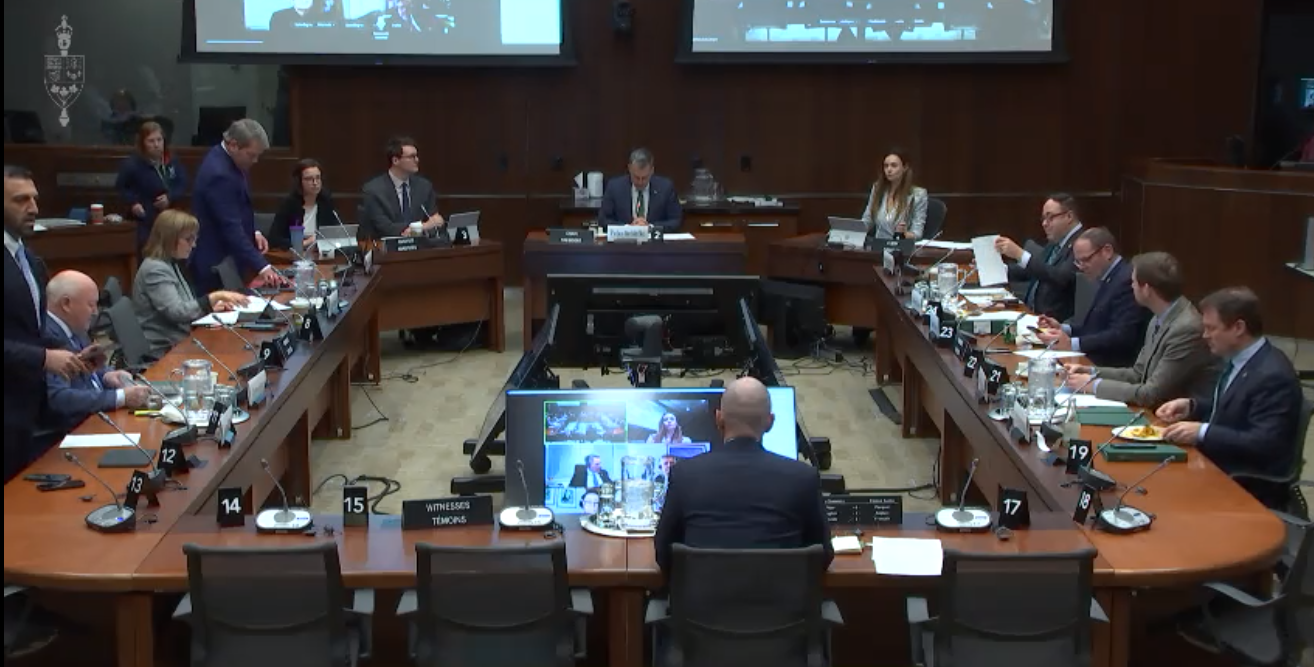Blog /
Canadian Chamber Addresses Importance of Large Port Infrastructure Expansion Projects Before House Committee
Canadian Chamber Addresses Importance of Large Port Infrastructure Expansion Projects Before House Committee
On March 31, 2023, we addressed the significance of large port infrastructure expansion projects for Canada’s trade and economic growth before the House of Commons Standing Committee on Transport, Infrastructure and Communities.

In his appearance before the Standing Committee on Transport, Infrastructure and Communities, Robin Guy, Vice President & Deputy Leader, Government Relations at the Canadian Chamber of Commerce, highlighted the significance of large port infrastructure expansion projects for Canada’s trade and economic growth.
As a trading nation heavily reliant on moving goods, investing in trade infrastructure is crucial to ensure efficient movement of essential goods and maintain competitiveness. Guy emphasized the need for long-term investment in trade infrastructure, including marine ports, railways, airports, and road systems, to support reliable supply chains and address challenges both now and in the future. He stressed the importance of government leadership in infrastructure investment, the need for funding and strategic vision for trade corridors, and the acceleration of regulatory modernization to attract investment and foster economic opportunities.
His full remarks are available below.
“Good morning, Mr. Chair and honourable members,
It is a pleasure to be appearing again before this Standing Committee. On behalf of the Canadian Chamber of Commerce, I would like to thank you for the opportunity to provide comment on the Committee’s study on ‘Large Port Infrastructure Expansion Projects in Canada.’
The Canadian Chamber of Commerce is the country’s largest business association with an active network of over 400 chambers of commerce and boards of trade representing nearly 200,000 businesses of all sizes, in all sectors and regions of our country.
As a trading nation, it is safe to say that trade infrastructure matters more to Canada than many other countries around the world. In fact, two out of every three dollars that Canada makes rely on moving goods. This is significantly higher than the OECD average of just over 50%.
Simply put, Canada needs to continue invest in trade infrastructure, including large port infrastructure expansion projects. Without focusing on these projects, we will not be able to get goods like food, fuel, fertilizer and critical minerals to market. Without focusing on these projects, we risk becoming less competitive. And without focusing on these projects we risk not being able to grow our economy.
Canada’s supply chains are only as strong as our weakest link. While we are seeing improvements, supply chain issues remain a key obstacle to growth for business. According to the most recent Statistics Canada Canadian Survey on Business Conditions, a quarter of business are still identifying supply chain challenges as a key concern, and one that they expect to persist further into 2023.
As we eagerly await Budget 2023 to be tabled by the Deputy Prime Minister and Minister of Finance later today, the message the business community is looking to hear is related to economic growth. Enhancing our trade infrastructure is a key ingredient that will support growing our economy.
In the time remaining, please allow me to dig into this a bit further.
If Canada is looking to grow our economy, we need to see long term investment in Canada’s trade infrastructure, including not just our marine ports as they are only one part of the chain, but also our railways, airports, and road systems supporting it all. Businesses need to be able to get their goods to market efficiently, and reliably. We can’t just simply look to address the needs of today, but of the challenges and opportunities that we see 20 and 30 years from now.
There is a need for funding for projects that support redundancy in critical infrastructure to reduce risk of critical failures to supply chains – for example building new pipelines, bridges, railroads, marine ports and airports. Some of these investments include investing in projects that will expand rail in highly congested areas; increasing bridge capacity; and increasing industrial lands around airports and ports to sustain trade growth.
While government isn’t solely responsible for infrastructure investment, its leadership is critical. A federal commitment to major, strategic, long-term investments is key to building Canada’s trade infrastructure.
The Government’s National Trade Corridors Fund is a positive step forward. While it is supporting worthwhile projects in the key areas above, the government must work to increase the speed at which projects receive funding. Too often, projects are stalled due to government inefficiencies. It must work with business on ensuring transparency for projects and by continuing to demonstrate how funding is helping address supply chain challenges of both today and tomorrow.
Another critical step forward is developing a vision for Canada’s trade corridors.
Trade corridors are key to this transportation of goods, and the government must look to work with business to develop new gateway strategies, including those for Western, St. Lawrence and Arctic Gateways.
Each corridor strategy would lay out how government would work with provinces, the private sector, communities and Indigenous peoples to identify capacity challenges facing our corridor transportation systems and develop a pipeline of actionable solutions.
Lastly, we need government commitment to accelerating its regulatory modernization agenda. Regulatory effectiveness is integral to a competitive environment and requires regulating smarter to attract new economic opportunities to Canada.
Regulatory uncertainty and changing expectations in the regulatory process are a poison pill to those looking to invest billions of dollars developing new pipelines, new mines and other large-scale nation-building infrastructure projects. We need predictable timelines to encourage capital investment. It can’t take a decade to approve infrastructure projects. In this sense, streamlining the regulatory process and adopting strict timelines for approving major infrastructure projects is essential — and long overdue.
Thank you again for the opportunity to address the Committee and I look forward to your questions.”
Related News

Time to put reports into action, Chamber tells House Agriculture Committee

2022 Q3 Canadian Survey on Business Conditions: Inflation is the top issue. Labour pains intensifying, but price pressures and supply chains issues are improving




